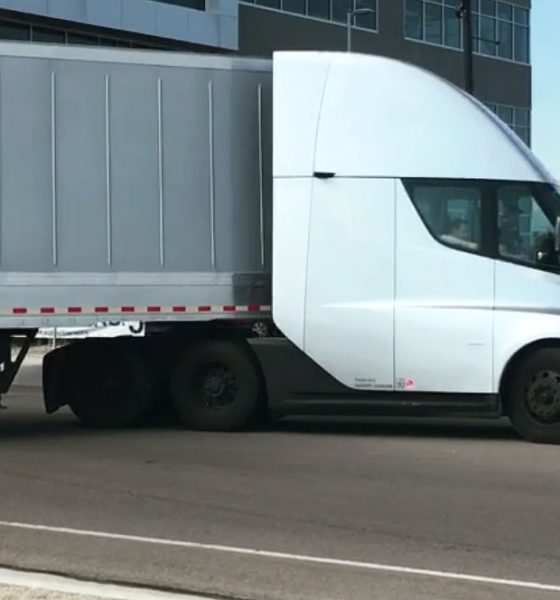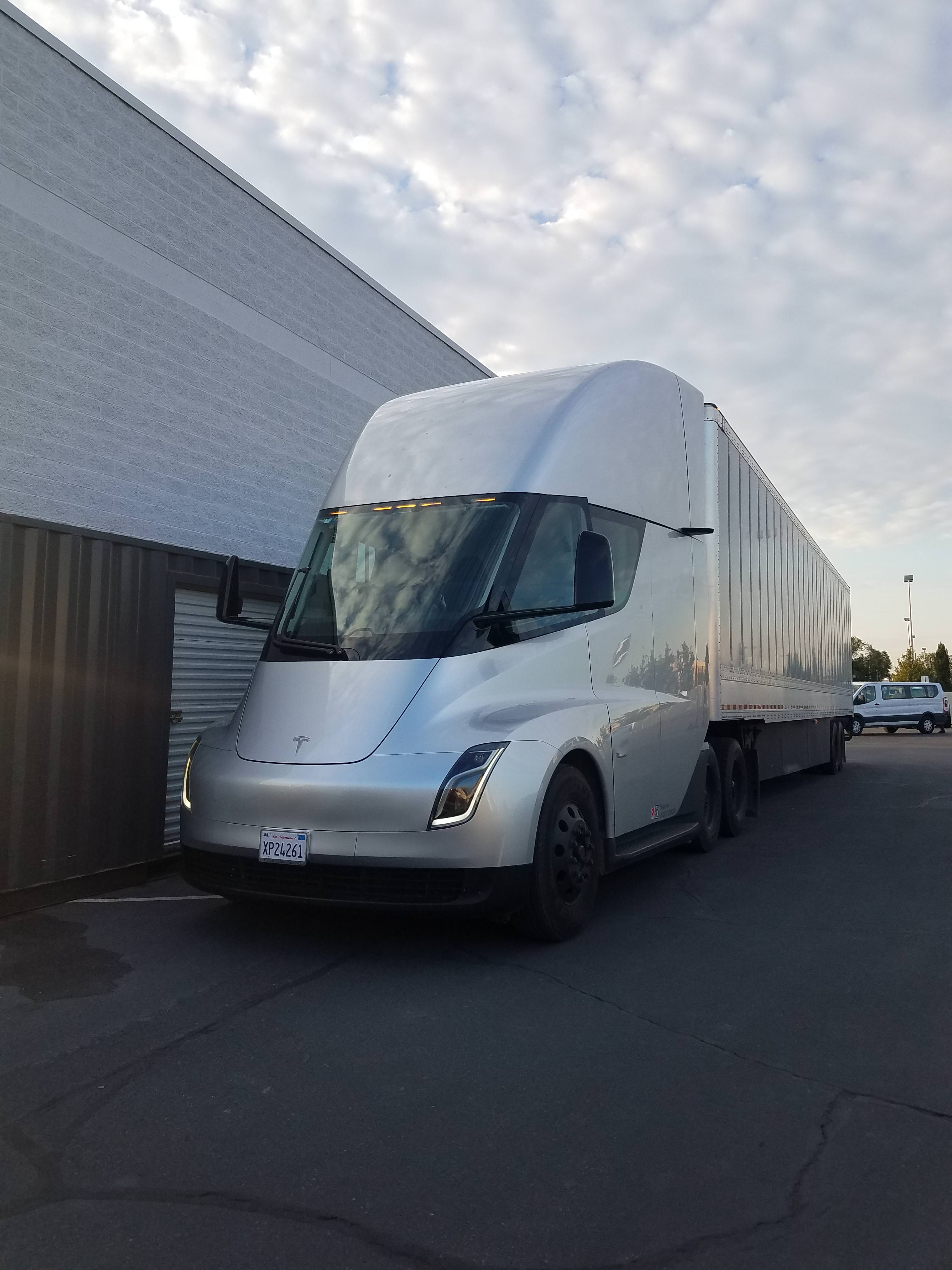

News
Tesla Semi with trailer showcases unearthly acceleration and sound in new sighting
Just like all of Tesla’s other offerings, the Semi is a very quick vehicle. Prior to the truck’s unveiling, Elon Musk noted in a TED Talk that the Semi would be a “very spry” truck that could be driven around like sports car.
Musk’s comments were eventually highlighted by the Semi’s specs, such as its 0-60 mph time of 5 seconds flat when launching without a trailer, as well as actual sightings of the vehicle accelerating like a high-performance sedan. Earlier this year, for one, the Semi was spotted performing a seemingly impromptu tire-shredding acceleration run while cruising on an area between Tesla’s Fremont factory and its Palo Alto headquarters.
The Semi has since been sighted in multiple states across the US, and during the company’s Q2 2018 earnings call, Jerome Guillen, the former head of Tesla’s truck programs who is now serving as the company’s President of Automotive, pointed out that the vehicle had already been improved since it was initially unveiled. The exact nature of these improvements remains to be seen, but if a video of the Semi captured earlier this month is any indication, it appears that the electric long-hauler has gotten even more daunting and impressive when it performs a full-speed acceleration run.

The Tesla Semi was sighted in Salt Lake City earlier this month, and not long after that, the truck visited the company’s office in Draper, UT. The vehicle attracted the attention of members of the Tesla community, including r/TeslaMotors subreddit member u/m3gusta_, who was able to capture the vehicle on video as it accelerated forward while hauling a trailer. The video was brief, but it was enough to show what the Semi looks and sounds like when it is launching with what seemed like the vehicle’s full power. Needless to say, the Tesla Semi’s quickness, as well as the unmistakable, high-pitched, futuristic sound of the truck’s four Model 3-derived electric motors, were nothing short of unearthly.
The Semi’s performance, handling, and power were specifically pointed out by professional driver Emile Bouret, a close friend of Tesla chief designer Franz von Holzhausen, in an Instagram post earlier this month. Bouret, who is no stranger to the power and performance of Tesla’s electric cars due to his work since the original Tesla Roadster (he also conducted the test drives in the next-gen Roadster during the Semi’s unveiling last year), noted that the Semi’s “speed and agility” were at odds with a vehicle of its size. Bouret further dubbed the electric long-hauler as a truck that is cool and crazy in equal measure.
Over the past month, sightings of the Semi have increased, with the vehicle being spotted traveling across several states and visiting some of its reservation holders like J.B. Hunt, UPS, and Ruan Transportation Management Systems. Tesla’s engineers accompanying the vehicle as it conducted its real-world tests have also begun sharing information about the truck to the Tesla community. During a stop in CO, for example, Tesla engineers shared details on the Semi’s upcoming sleeper cabin, the prototype’s carbon fiber construction, and the truck’s existing 26-camera system.
When the vehicle was unveiled last year, CEO Elon Musk noted that the Tesla Semi is expected to begin production sometime in 2019. As noted by Eric Markowitz & Dan Crowley of Worm Capital in a note published after a tour of Gigafactory 1, Tesla is planning on “earnestly” producing the Semi by 2020.
Watch the Tesla Semi launch with a trailer in the video below. Do note that this video is best viewed with the sound turned up.
https://streamable.com/vvkn6

News
Tesla (TSLA) receives “Buy” rating and $551 PT from Canaccord Genuity
He also maintained a “Buy” rating for TSLA stock over the company’s improving long-term outlook, which is driven by autonomy and robotics.

Canaccord Genuity analyst George Gianarikas raised his Tesla (NASDAQ:TSLA) price target from $482 to $551. He also maintained a “Buy” rating for TSLA stock over the company’s improving long-term outlook, which is driven by autonomy and robotics.
The analyst’s updated note
Gianarikas lowered his 4Q25 delivery estimates but pointed to several positive factors in the Tesla story. He noted that EV adoption in emerging markets is gaining pace, and progress in FSD and the Robotaxi rollout in 2026 represent major upside drivers. Further progress in the Optimus program next year could also add more momentum for the electric vehicle maker.
“Overall, yes, 4Q25 delivery expectations are being revised lower. However, the reset in the US EV market is laying the groundwork for a more durable and attractive long-term demand environment.
“At the same time, EV penetration in emerging markets is accelerating, reinforcing Tesla’s potential multi‑year growth runway beyond the US. Global progress in FSD and the anticipated rollout of a larger robotaxi fleet in 2026 are increasingly important components of the Tesla equity story and could provide sentiment tailwinds,” the analyst wrote.
Tesla’s busy 2026
The upcoming year would be a busy one for Tesla, considering the company’s plans and targets. The autonomous two-seat Cybercab has been confirmed to start production sometime in Q2 2026, as per Elon Musk during the 2025 Annual Shareholder Meeting.
Apart from this, Tesla is also expected to unveil the next-generation Roadster on April 1, 2026. Tesla is also expected to start high-volume production of the Tesla Semi in Nevada next year.
Apart from vehicle launches, Tesla has expressed its intentions to significantly ramp the rollout of FSD to several regions worldwide, such as Europe. Plans are also underway to launch more Robotaxi networks in several more key areas across the United States.
News
Waymo sues Santa Monica over order to halt overnight charging sessions
In its complaint, Waymo argued that its self-driving cars’ operations do not constitute a public nuisance, and compliance with the city’s order would cause the company irreparable harm.

Waymo has filed a lawsuit against the City of Santa Monica in Los Angeles County Superior Court, seeking to block an order that requires the company to cease overnight charging at two facilities.
In its complaint, Waymo argued that its self-driving cars’ operations do not constitute a public nuisance, and compliance with the city’s order would cause the company irreparable harm.
Nuisance claims
As noted in a report from the Los Angeles Times, Waymo’s two charging sites at Euclid Street and Broadway have operated for about a year, supporting the company’s growing fleet with round-the-clock activity. Unfortunately, this has also resulted in residents in the area reportedly being unable to sleep due to incessant beeping from self-driving taxis that are moving in and out of the charging stations around the clock.
Frustrated residents have protested against the Waymos by blocking the vehicles’ paths, placing cones, and “stacking” cars to create backups. This has also resulted in multiple calls to the police.
Last month, the city issued an order to Waymo and its charging partner, Voltera, to cease overnight operations at the charging locations, stating that the self-driving vehicles’ activities at night were a public nuisance. A December 15 meeting yielded no agreement on mitigations like software rerouting. Waymo proposed changes, but the city reportedly insisted that nothing would satisfy the irate residents.
“We are disappointed that the City has chosen an adversarial path over a collaborative one. The City’s position has been to insist that no actions taken or proposed by Waymo would satisfy the complaining neighbors and therefore must be deemed insufficient,” a Waymo spokesperson stated.
Waymo pushes back
In its legal complaint, Waymo stated that its “activities at the Broadway Facilities do not constitute a public nuisance.” The company also noted that it “faces imminent and irreparable harm to its operations, employees, and customers” from the city’s order. The suit also stated that the city was fully aware that the Voltera charging sites would be operating around the clock to support Waymo’s self-driving taxis.
The company highlighted over one million trips in Santa Monica since launch, with more than 50,000 rides starting or ending there in November alone. Waymo also criticized the city for adopting a contentious strategy against businesses.
“The City of Santa Monica’s recent actions are inconsistent with its stated goal of attracting investment. At a time when the City faces a serious fiscal crisis, officials are choosing to obstruct properly permitted investment rather than fostering a ‘ready for business’ environment,” Waymo stated.
News
Tesla FSD v14.2.2 is getting rave reviews from drivers
So far, early testers have reported buttery-smooth drives with confident performance, even at night or on twisty roads.

Tesla Full Self-Driving (Supervised) v14.2.2 is receiving positive reviews from owners, with several drivers praising the build’s lack of hesitation during lane changes and its smoother decision-making, among others.
The update, which started rolling out on Monday, also adds features like dynamic arrival pin adjustment. So far, early testers have reported buttery-smooth drives with confident performance, even at night or on twisty roads.
Owners highlight major improvements
Longtime Tesla owner and FSD user @BLKMDL3 shared a detailed 10-hour impression of FSD v14.2.2, noting that the system exhibited “zero lane change hesitation” and “extremely refined” lane choices. He praised Mad Max mode’s performance, stellar parking in locations including ticket dispensers, and impressive canyon runs even in dark conditions.
Fellow FSD user Dan Burkland reported an hour of FSD v14.2.2’s nighttime driving with “zero hesitations” and “buttery smooth” confidence reminiscent of Robotaxi rides in areas such as Austin, Texas. Veteran FSD user Whole Mars Catalog also demonstrated voice navigation via Grok, while Tesla owner Devin Olsen completed a nearly two-hour drive with FSD v14.2.2 in heavy traffic and rain with strong performance.
Closer to unsupervised
FSD has been receiving rave reviews, even from Tesla’s competitors. Xpeng CEO He Xiaopeng, for one, offered fresh praise for FSD v14.2 after visiting Silicon Valley. Following extended test drives of Tesla vehicles running the latest FSD software, He stated that the system has made major strides, reinforcing his view that Tesla’s approach to autonomy is indeed the proper path towards autonomy.
According to He, Tesla’s FSD has evolved from a smooth Level 2 advanced driver assistance system into what he described as a “near-Level 4” experience in terms of capabilities. While acknowledging that areas of improvement are still present, the Xpeng CEO stated that FSD’s current iteration significantly surpasses last year’s capabilities. He also reiterated his belief that Tesla’s strategy of using the same autonomous software and hardware architecture across private vehicles and robotaxis is the right long-term approach, as it would allow users to bypass intermediate autonomy stages and move closer to Level 4 functionality.








